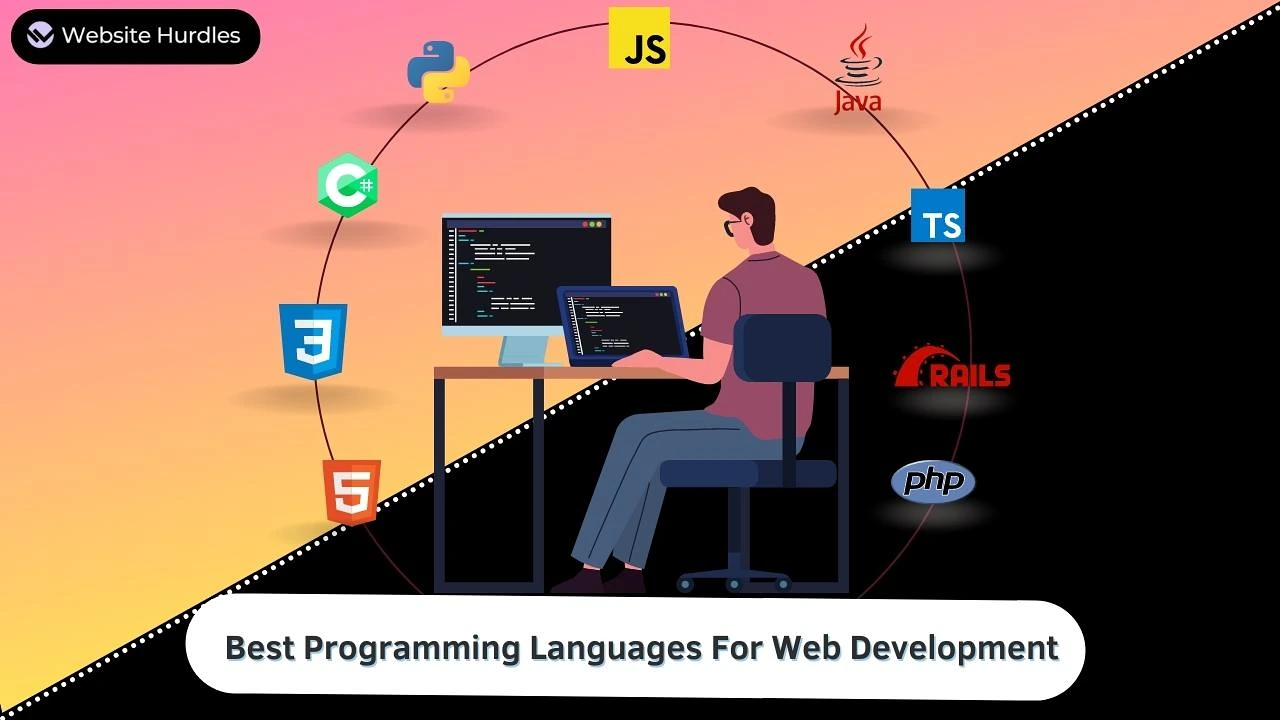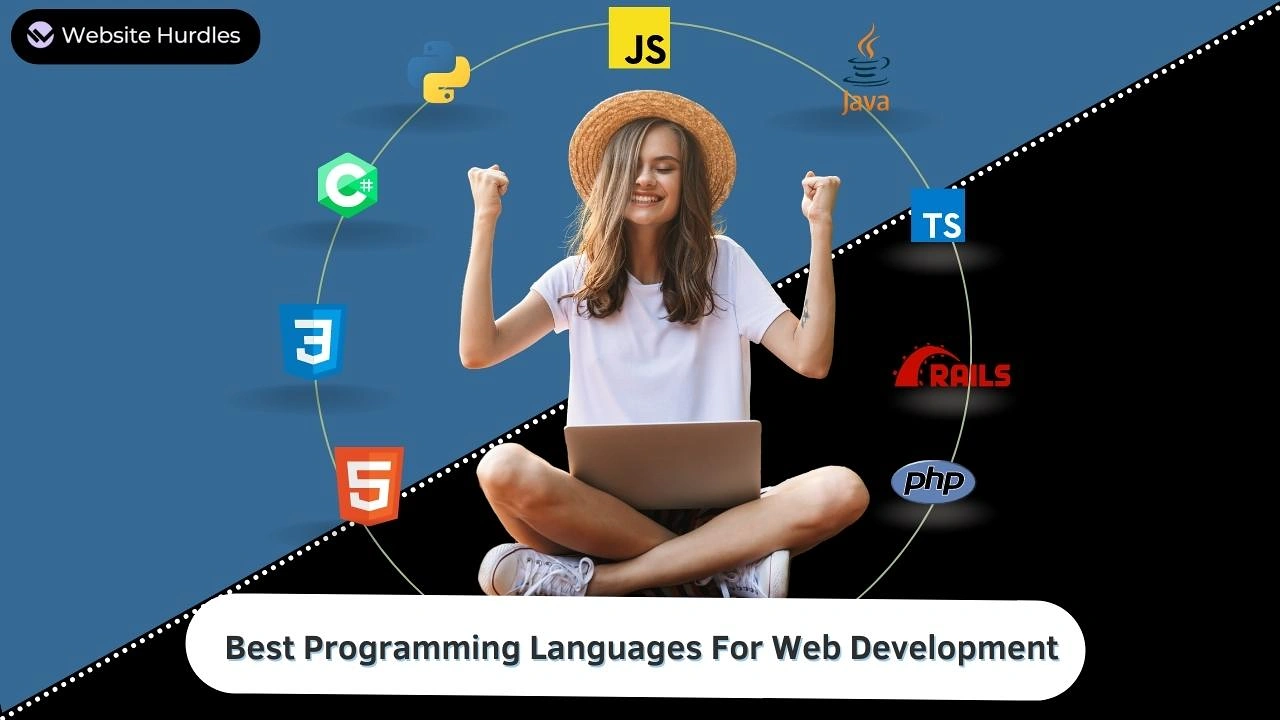Web development thrives on a diverse set of programming languages, each tailored to specific purposes in crafting captivating websites and web applications.
In this article, we will explore the 9 best programming languages for web development, discussing the unique features, pros, and cons of each language.
Without further ado, let’s get started.
1. HTML (Hypertext Markup Language)
HTML serves as the foundation of web development, providing the structure and layout for web pages.
Using tags, HTML defines elements such as headings, paragraphs, images, and links. These tags create the backbone of a webpage, which is then enhanced with CSS for visual appeal.
Features
- Simple syntax with easy-to-understand tags.
- Semantic structure for content organization.
- Supports multimedia integration through images and videos.
- Facilitates accessibility features for an inclusive web experience.
Pros
- Universally supported by all browsers.
- Requires no additional tools or compilers to use.
- Excellent for building static web pages or quick prototypes.
Cons
- Limited interactivity without the use of JavaScript.
- Not suitable for complex web applications requiring real-time updates.
2. CSS (Cascading Style Sheets)
CSS complements HTML by adding style and design to web pages.
Developers use CSS to control layout, colors, fonts, and overall content presentation.
CSS operates in a cascading manner, where styles can be inherited or overridden, ensuring consistency throughout the website.
Features
- Selectors to target specific HTML elements for styling.
- Various units for sizing elements, such as pixels, percentages, and ems.
- Supports media queries for responsive design across devices.
- Allows animations and transitions for interactive user experiences.
Pros
- Separates content and presentation, promoting better maintainability.
- Ensures consistent styles across a website with cascading rules.
- Improves page loading times by reducing inline styling.
Cons
- Steeper learning curve for complex layouts and positioning.
- May encounter browser compatibility issues that require vendor prefixes.
3. JavaScript
JavaScript is a versatile and powerful scripting language that enables interactivity and dynamic behavior in web pages.
It is extensively used for building client-side applications and has become essential for modern web development.
Additionally, JavaScript supports server-side development through frameworks like Node.js.
Features
- Event-driven programming model for handling user interactions.
- Manipulates the Document Object Model (DOM) for dynamic updates.
- Supports asynchronous programming with promises and async/await.
- Boasts an extensive ecosystem with libraries and frameworks like React, Angular, and Vue.
Pros
- Enhances user experience with responsive and interactive web elements.
- Utilized both on the client side and server side for full-stack development.
- Active community with continuous updates and improvements.
Cons
- Potential security vulnerabilities, like cross-site scripting (XSS) attacks.
- Varied browser support for certain features may lead to compatibility issues.
4. PHP
PHP is a server-side scripting language specially designed for web development.
It has been extensively used to create dynamic web pages, content management systems (CMS), and other server-side applications.
Features
- Seamless integration with HTML for dynamic content generation.
- PHP supports multiple databases, making it versatile for data-driven applications.
- Extensive community support with a wealth of online resources.
- Simple syntax and vast built-in functions for rapid development.
Pros
- Wide adoption and compatibility with various web servers and platforms.
- Excellent for creating custom CMS and e-commerce solutions.
- Efficient performance for web applications and database interactions.
Cons
- Inconsistent function naming and parameter order in older versions.
- Vulnerable to security issues if not implemented properly.
5. Python
Python is a versatile, high-level programming language known for its simplicity and readability.
Although not originally designed for web development, its extensive libraries and frameworks make it a popular choice for building web applications and APIs.
Features
- Clean and expressive syntax, reducing the amount of code needed.
- Supports multiple paradigms, including object-oriented and functional programming.
- Rich library ecosystem, such as Django and Flask, for web development.
- Excellent for data manipulation and analytics in web applications.
Pros
- Easy to learn and use, making it beginner-friendly.
- High productivity and faster development with reusable code components.
- Cross-platform compatibility for running web applications on different environments.
Cons
- Slower execution speed compared to languages like C++ or Go.
- May not be the best choice for real-time or performance-critical applications.

6. Java
Java is renowned for its security and platform independence.
With the Java Servlet API and frameworks like Spring, it facilitates building robust and scalable web applications.
Features
- Platform-independent nature through the Java Virtual Machine (JVM).
- Strongly typed language, ensuring safer and more robust code.
- Extensive standard library for a wide range of functionalities.
- Exception handling for effective error management.
Pros
- High performance and stability for enterprise-level applications.
- Wide adoption and vast community support.
- Excellent for building complex web applications.
Cons
- Requires more boilerplate code compared to languages like Python.
- Slower development cycle due to the compile-build-run process.
7. TypeScript
TypeScript is a powerful extension of JavaScript, introducing static typing for better code maintainability and productivity in large-scale web applications.
Features
- Optional static typing for variables, function parameters, and return types.
- Allows developers to catch errors during development, enhancing code reliability.
- Language features like interfaces and enums, promoting better code organization.
- Compatibility with JavaScript, making it seamless to integrate into existing projects.
Pros
- Enhanced code readability and maintainability.
- Early error detection during development, reducing runtime errors.
- Support for modern JavaScript features while targeting older browser versions.
Cons
- Learning curve for developers transitioning from JavaScript.
- Additional build step required to compile TypeScript into JavaScript.
8. Ruby
Ruby, coupled with the Ruby on Rails framework, promotes elegant and efficient web development.
It follows the “convention over configuration” philosophy, accelerating project delivery.
Features
- Concise and expressive syntax, emphasizing developer happiness.
- Ruby on Rails, a full-stack framework with built-in features like routing and database ORM.
- Promotes clean code organization through conventions.
- Active Record, facilitating database interactions with minimal configuration.
Pros
- Rapid development with code efficiency and readability.
- Abundance of gems (libraries) available for extending functionality.
- Strong community support with active contributions.
Cons
- May not be as performant as lower-level languages like C++ or Java.
- Limited scalability for highly concurrent applications.
9. C#
C# is an object-oriented programming language developed by Microsoft.
It is ideal for web development within the Microsoft ecosystem and seamlessly integrates with other Microsoft technologies.
Features
- Strongly typed language, ensuring type safety and code robustness.
- Provides features like properties, delegates, and LINQ for code organization.
- Integration with .NET framework, offering powerful functionalities.
- Used in combination with ASP.NET for web application development.
Pros
- Seamless integration with Microsoft technologies and tools.
- High performance and scalability for enterprise applications.
- Extensive documentation and support from Microsoft.
Cons
- Limited cross-platform capabilities compared to languages like Python or Java.
- Learning curve for developers not familiar with the .NET ecosystem.
Table Summary of the Best Web Development Languages
| Web Development Languages | Individual Web Development Roles |
|---|---|
| HTML | The Building Blocks of the Web |
| CSS | Styling the Web |
| JavaScript | Interactive Web Experiences |
| Python | Versatility and Simplicity |
| PHP | Powering Dynamic Websites and CMS |
| Java | Security and Platform Independence |
| TypeScript | Typing for Better Code Quality |
| Ruby | Elegant Web Development with Rails |
| C# | Seamless Integration with Microsoft |
FAQs
1. Which programming language is best for beginners in web development?
For beginners, HTML, CSS, and JavaScript are excellent starting points.
They form the core foundation of web development and are relatively easy to learn, allowing aspiring developers to get hands-on experience quickly.
2. What is the most popular programming language for web development?
JavaScript remains the most popular language for web development, as it enables interactive and dynamic web experiences.
3. Can I use multiple programming languages in a single web development project?
Absolutely! Web development often involves using a combination of languages to achieve various functionalities.
For example, HTML, CSS, and JavaScript work together to create the front end, while server-side languages like Python, PHP, Java, or Ruby handle the backend operations.
4. What is the significance of TypeScript in web development?
TypeScript is valuable for large-scale web applications due to its optional static typing. It helps catch errors during development, enhances code reliability, and provides better code organization.
Moreover, TypeScript is fully compatible with modern JavaScript, making it a popular choice for developers seeking improved code quality.
5. Is Python suitable for web development despite being a general-purpose language?
Yes, Python is widely used in web development due to its simplicity, readability, and versatility.
With frameworks like Django and Flask, Python becomes a powerful tool for building web applications, APIs, and content management systems.
6. Which language is better for enterprise-level web applications, Java, or C#?
Both Java and C# are robust choices for enterprise-level web applications. Java’s platform independence and extensive standard library make it popular for cross-platform solutions.
On the other hand, C#’s seamless integration with Microsoft technologies and the .NET framework offers high performance and scalability in the Microsoft ecosystem.
The choice ultimately depends on the specific project requirements and the developer’s familiarity with the respective ecosystems.
Website Hurdles Recommended Article:
- How to Become a Web Developer: The Ultimate Guide
- Web Development Prerequisites
- Traits of Successful Frontend Developers
- How to Build a Web Developer Portfolio from Scratch
- How to Become a Freelance Web Developer: (Earn up to $500k/year)
- Steps to Master Web Development like a PRO
Final Thoughts
The mentioned programming languages all play vital roles in web development.
– HTML and CSS form the backbone of web pages, while JavaScript brings life to them with interactive features.
– Python and PHP offer versatility and efficiency, each catering to specific use cases in web development.
– Java brings robustness and platform independence to web applications, making it an excellent choice for enterprise-level projects.
TypeScript adds type safety to JavaScript, improving code quality and maintainability.
– Ruby, with its elegant syntax and Ruby on Rails framework, promotes rapid development and clean code organization.
– C# seamlessly integrates with the Microsoft ecosystem, offering high performance and scalability.
By understanding the strengths and weaknesses of these languages, web developers can make informed choices to build outstanding web experiences.






0 Comments